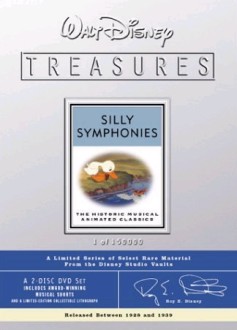By Lindsay Mayer
I'd still like to know how he pulled it off, personally. Back at the turn of the millennium, film critic/historian and longtime Disney associate (not to mention fan) Leonard Maltin presented a concept to the Disney elite of releasing the studio's lesser-known archive material in a special DVD line. What resulted was one of the best collector's DVD lines Disney, not to mention any other studio, has produced: the Walt Disney Treasures. This unique line of 2-disc DVD sets, which are released in waves of 3 or 4 on every first Tuesday of December to celebrate Walt Disney's birthday, has been providing avid Disney fans with historic archival content - anywhere from early animated shorts to TV series to other rare and little-known material - for over 5 years. This particular set, Silly Symphonies: The Historic Musical Animated Classics, was one of the first four Treasures released back on December 4th, 2001. Highly collectible, the Treasures contain rare content, are housed in fancy packaging, and are produced in limited numbers of a few hundred thousand copies. Specifically, each title in this first wave came in at 150,000 copies each, but for all of their rarity, the retail price was set at a very reasonable $32.99.
The Silly Symphonies were a series of musically-themed animated shorts that launched in 1929 and ended exactly ten years later in 1939. Disney's chief composer Carl Stalling (who would later reach even greater fame as the main Looney Tunes composer for Warner Bros.) began to grow weary of writing music to match the pre-determined action and gags of the animation in his early shorts. Stalling prompted the concept of animation dictated by the flow of music instead. With this, Walt eventually produced a line of unique, unrelated animated shorts known as the Silly Symphonies. Shown before the feature film along with newsreels and serials, the Symphonies did not feature known cartoon characters like Mickey Mouse and the concept was a slow start with Walt's distributor at the time. Eventually, though, the shorts found success with the public; even egregious popularity, as was the case with Three Little Pigs.
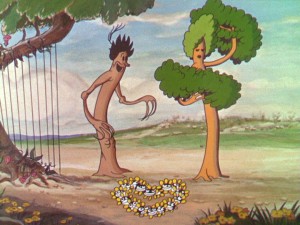 
The Symphonies were also developed with another purpose in mind - as a "training ground" for early Disney animators to experiment with new concepts and techniques such as the Technicolor process, speed lines to indicate acceleration, the multiplane camera, and much more. These shorts proved to be a valuable resource and learning experience for the studio staff, especially before the production of their first feature-length animated film, Snow White and the Seven Dwarfs. Ironically, Snow White's success caused the eventual retirement of the Symphony shorts; as animated feature films became the future of the studio, the shorts that had served their technical purpose were ended two years after the arrival of the ebony-haired princess.
The Silly Symphonies DVD, being part of the first wave of Walt Disney Treasures, set the unique standard for the Treasures packaging that continues through to this day. The discs are housed in a book-like, dark gray double keep case, which also contains a collectible lithograph card featuring a reproduction of the original poster art for Flowers and Trees as well as a silver booklet giving a short overview of the Symphonies and an outline of DVD content. The keep case itself is housed inside a brushed aluminum "tin," which originally came with a blue cardboard band around the bottom. This removable band gave a bit more description to the product (such as the span of years in which the content was produced), and featured a facsimile signature of Walt's nephew Roy E. Disney, giving the set a further air of authority as it was supposedly approved by the Disney family themselves. As the collectible Treasures line is produced in limited numbers, the outer case also featured the individual production number of your personal copy; for example, mine is 059,090 of 150,000.
The aesthetics of the Treasures packaging has gradually deteriorated with each passing year; stamped production numbers are gone, as well as the cardboard bands. The back covers of the aluminum cases are no longer printed directly on the metal - rather a flimsy card has been loosely glued to the back and falls off almost immediately after the DVD is opened. Even the Walt Disney Treasures title is not properly and fully embossed in the metal, and pieces of letters go missing. Through all of its packaging woes, however, the historic content of this line has remained a valuable source of the Disney studio's past for fans to enjoy; even though the physical video quality of the content is beginning to change for the worse, as well.
DISC 1
Of the 75 total shorts produced in the 10-year era of the Silly Symphonies, 37 are contained on this set. Luckily, a recent insider tip has hinted at the likelihood of a second volume of Symphonies set for release in this year's Walt Disney Treasures wave, which would theoretically mean the remaining 38 shorts would see a properly compiled release 5 years after the original set came out. Although several Symphonies have made scattered appearances as extra features on subsequent Disney DVD releases, the slated second volume would, hopefully, gather the remaining cartoons together and present them in their full, restored, uncensored form. The 37 available shorts are nothing to sniff at, themselves. An elaborate form of a "best of" compilation, the set features several landmark and critically-acclaimed Symphonies, such as The Skeleton Dance, The Old Mill, Three Little Pigs, and the 1939 Ugly Duckling, the last Symphony produced.
Though it features a "play all" function, this set lacks an alphabetical or chronological listing like several of the later Walt Disney Treasures. Instead, it offers its random assortment of shorts in a thematic grouping. On disc 1, the shorts are sorted under "Fables and Fairy Tales" and "Favorite Characters" - the latter of which contains many a sequel or two to some of the more popular Symphonies like Three Little Pigs.
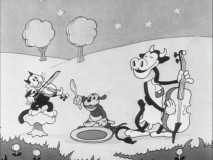  
THE SHORTS
Mother Goose Melodies (1931) (8:11)
Old King Cole leads the proceedings as a book full of Mother Goose fables is set to lively music. Several tales are cleverly referenced both musically and visually, and the short is overall quite entertaining for all of its simplicity.
Babes in the Woods (1932) (7:42)
A Technicolor take on the Hansel and Gretel story of old, this version has the siblings detour to a village of friendly gnomes before being taken by the two-faced witch. In addition, the children (and many others before them) are turned into animals rather than fattened on the witch's candy house. Before Gretel is bewitched into a rat, however, the gnomes come to the rescue, and she and her brother turn all the imprisoned animals back into children.
Lullaby Land (1933) (7:24)
A surreal dreamscape is the chosen setting for this short, as a baby, being rocked to sleep by his mother, enters into "a Lullaby Land of Nowhere." He and his plushie dog companion explore the toy-filled landscape, and soon wander into the Forbidden Gardens - an area full of hazardous things like knives, tacks, matches, and fountain ink pens. After a frightening encounter with three Boogey Men, the baby is discovered by the friendly Sand Man and lulled into a deep sleep.
Three Little Pigs (1933) (8:42)
This famous Symphony tells the simple and well-known Western story of the three little pigs. The short gained an unusual amount of popularity after its debut however; many saw its featured song "Who's Afraid of the Big Bad Wolf?" as an anthem for hardy souls to live by in the Depression era which was occurring at the time. Unfortunately, this is the only short on the set to suffer censorship; the original depiction of the wolf as a stereotypical Jewish peddler to trick the pigs was not reinstated in the full short, though you can see a short clip of it in Leonard Maltin's intro.
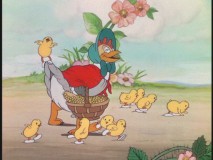 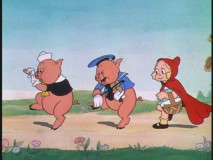 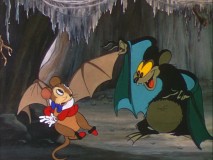
The Wise Little Hen (1934) (7:41)
Adapted from the classic Aesop fable The Little Red Hen, this short tells the story of a hen and her chicks in search of help for planting and growing a field of corn. She first appeals to Peter Pig, then later visits Donald Duck - also marking the first appearance of Donald in any Disney film. Neither of them find the task appealing, so they malinger their way out of not one, but two requests. The hen gets the last laugh however - cooking, baking and boiling all of the corn for she and her family to eat by themselves.
The Big Bad Wolf (1934) (9:22)
The first of three sequels made for the highly popular Three Little Pigs, this features a spin on the Little Red Riding Hood story, as the two foolish pigs advise the girl to take a shortcut through the forest to get to her grandmother's house. The third, Practical Pig, strongly warns against this - but alas, the shortcut is taken anyway. Sure enough, the wolf appears and though he tries (and fails) to capture a meal in the woods, he makes a second attempt at Red Riding Hood's grandmother's house. Though the cowardly Fifer and Fiddler pig have run away, Practical Pig comes to the rescue by... popping popcorn in the wolf's pants? Less entertaining than its predecessor, the inclusion of the pigs in the story also feels arbitrary and contrived, and done solely to profit on their popularity.
The Flying Mouse (1934) (9:19)
This short chronicles the story of a daydreaming mouse who badly wants to fly - so much so that he'll try it with leaves on his paws. When he rescues a fairy from a spider web, his reward wish is spent on - what else? - wings! To his unfortunate discovery, however, he finds himself unable to fit in anywhere, and upon his pleading the fairy reverses the wish. The moral of this short is rather ambiguous - whether it's faulting the mouse for dreaming of something more, or encouraging the 'be yourself' mantra - it is really unclear.
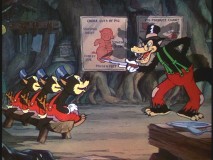  
Three Little Wolves (1934) (9:21)
A second sequel to Three Little Pigs, this one depicts the wolf as a father of three delinquent cubs - and he is wasting no time teaching them the location of various tasty bits on the body of a pig. This short is also a spin on The Boy Who Cried Wolf, as the irresponsible Fifer and Fiddler Pigs use the emergency wolf horn to fool their brother into a false alarm. When the two are eventually captured by the wolf and his boys, help is long in coming since they've lost Practical Pig's trust. The most dynamic Pigs short in terms of action and character movement, this one still pales in comparison to its original.
The Grasshopper and the Ants (1934) (8:25)
Yet another Aesop fable, this Symphony short spawned a catchy song and featured some of Pinto Colvig (Goofy)'s early voice work. A hedonistic grasshopper frolics and plays in the summer rays and laughs at a colony of hard-working ants. But once the dead of winter sets in, the grasshopper finds himself imploring the ants for their help to survive the cold.
The Golden Touch (1935) (10:03)
Gold-lovin' King Midas is visited by a magical being (who sounds an awful lot like a munchkin) named Goldy who is willing to offer him the gift of The Golden Touch, but not before a substantial Leonard Maltin-like disclaimer first. Midas brushes his warnings aside and accepts the "gift" greedily, but soon discovers the hard way that there is more to life than gold-like food, for example. Midas cannot eat a morsel before it converts into 18 karat gold. Upon Goldy's reappearance, Midas begs him to take the Touch back. Goldy does so, but at a price - everything that Midas possesses. But at least the king got a delicious hamburger out of the deal - with onions!
The Robber Kitten (1935) (7:47)
A mischievous kitten named Ambrose decides to run away and become a professional robber - right in time to avoid a bath, too! Shortly thereafter he meets Dirty Bill, a real bandit who is amiable enough at first; but things take a turn for the worst when Bill angrily demands to have Ambrose's "loot" - which consists of a bag of cookies. The kitten does not linger to suffer the consequences; he runs straight home to mom and the cooling bathwater.
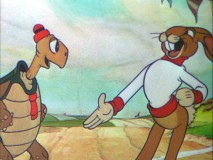 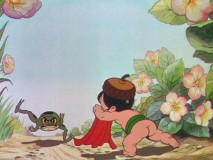 
The Tortoise and the Hare (1935) (8:37)
Toby Tortoise and Max Hare compete in a race in this adaptation of the classic Aesop's fable. While Max stops to flirt and show off to four cute cottontail girls, Toby catches up and wins the race by a neck - literally! This short was originally produced to experiment with the depiction of extreme speed and the speedline gag - which was a new and novel concept at the time.
Water Babies (1935) (8:14)
For your daily dose of "teh kewt," please refer to Water Babies - a Symphony short based on an 1863 story by Charles Kingsley. It basically consists of tiny, abysmally cute baby characters (complete with cute baby butts) that sleep in water lily flowers at night, and frolic and play all day long with their fellow wetland wildlife. Riding in leaf boats, on the backs of swans, or the tails of lizards, you play witness to a day of fun as the water babies... well, play!
Who Killed Cock Robin? (1935) (8:30)
A charming, musical take on the age-old nursery rhyme. Cock Robin is run through by an arrow right as he is serenading Jenny Wren - a busty caricature of Mae West, right down to the throaty voice. A trial ensues, but no suspects can be satisfactorily convicted. Then a rather effeminate Cupid bird shows up, and confirms that he shot Cock Robin - but that the suitor was only conked on his head when he fell. A happy ending is had for all when Robin wakes up and shares a passionate smooch with a swooning Jenny.
Elmer Elephant (1936) (8:30)
A young jungle romance is the center of this story, and begins with the title character bringing a bouquet of flowers to Tillie Tiger's birthday party. Tillie enthusiastically receives his gift, but when she turns her back the other boys ridicule Elmer's trunk and throw him out of the party. The self-conscious Elmer is consoled by an elderly giraffe and a trio of pelicans - all proud of their idiosyncrasies in design. Suddenly sirens are heard and Elmer soon finds out that Tillie is trapped by a raging fire. In his rush to save the cute cub, Elmer finds his trunk is a most wonderful thing after all - especially when its hose-like abilities can save damsels beset by flame!
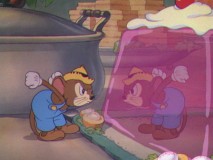 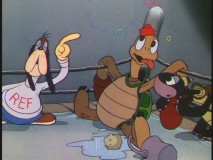 
The Country Cousin (1936) (9:16)
Feeling more like a typical MGM short than a Silly Symphony, The Country Cousin is a spin on the classic Town Mouse and Country Mouse Aesop fable, and has the naοve country mouse Abner is invited by his city relative Monty to stay with him
for a while. Abner delights to a great, fancy spread of food, but is constantly dogged by Monty to "shoosh!" After too much champagne, Abner finds himself in trouble when he rouses the household cat. Fleeing to the streets, Abner discovers even more noise and trouble than inside. He flees fast down the train tracks from whence he came, back to his beloved town of Podunk.
Toby Tortoise Returns (1936) (7:29)
This is a very interesting "crossover" short, featuring cameo appearances by other Silly Symphonies characters as audience members in a big boxing match between Max Hare and Toby Tortoise. Among the cameos are the previously discussed Jenny Wren, Elmer Elephant, and all three little pigs. A Droopy Dog-like character referees the match, and the short on a whole oddly reflects a Tex Avery/Warner Bros. style of humor rather than a Disney, or even Silly Symphony, type of tone. As with the original short, Max's arrogance ends up backfiring on him - but in a much more extravagant fashion!
Wynken, Blynken, and Nod (1938) (8:18)
Based on the original children's poem by Eugene Field, this rather elegant Symphony short incorporates many techniques learned and perfected by the Disney artists in the nine years that the series had then been produced. Set in a cloudy dreamscape, three sleepy babes go fishing amongst the stars in a wooden shoe boat, eventually getting caught in a storm and tumbling to earth, revealing themselves to be a just-completed dream by a sleeping toddler.
The Practical Pig (1939) (8:22)
In this third Three Little Pigs sequel, and the second-to-last Symphony produced, Practical Pig is again busy at work on a protective, wolf-preventative invention - a homemade lie detector. His ever-irresponsible brothers Fiddler and Fifer go for a swim in the nearby pond - only to again be apprehended by the Big Bad Wolf and his three delinquent pups. This time the Papa Wolf isn't satisfied with just two though, and tries to trick Practical Pig into a trap, too. As usual though - Practical's too smart for that evil canine, and comes to the rescue of his brothers. Though it's little more than a new spin on the consistent Three Little Pigs formula, the short still entertains nicely.
NEXT >>
ONTO PAGE TWO
Buy Walt Disney Treasures: Silly Symphonies from Amazon.com Marketplace

REVIEW CONTENTS
Page 1: Set Overview and Disc 1 Shorts
Page 2: Disc 2 Shorts, Video & Audio, Bonus Features, Easter Eggs and Closing Thoughts |
|
